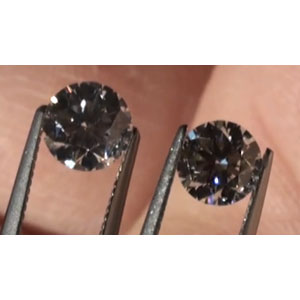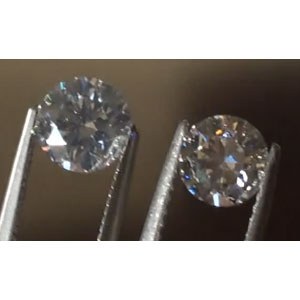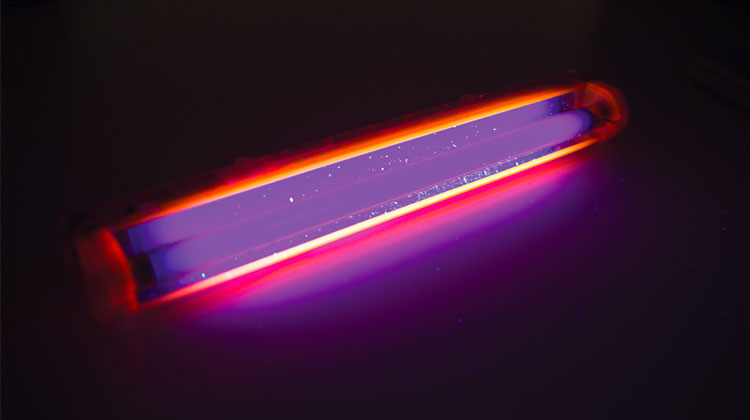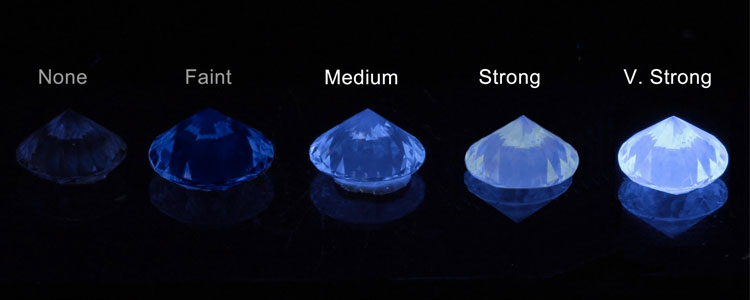Fluorescence occurs when a material absorbs ultraviolet light and then glows.
Most type-1a diamonds that fluoresce do so with a bluish glow (over 95% according to GIA) and the effect is caused by boron impurities that occur as a result of defects in the diamond’s crystal structure. Although much less common, it is also possible for a diamond to fluoresce with a different color such as yellow or white.
Because fluorescence is described rather than graded, it can be highly subjective. The fluorescence of a GIA certified diamond can be described as:
- None
- Faint
- Medium
- Strong
- Very Strong
(Photo courtesy of SamaraJames.com used with permission)
Note: AGSL groups the None and Faint ranges together in a Negligible grade.
How does fluorescence normally affect a diamond?
The more boron impurities are in a diamond, the more intense it will fluoresce. However, the intensity of the blue light being emitted also depends on the energy of the ultraviolet radiation that falls on the diamond. That energy is highly dependent on the light source and the distance between the light source and the diamond.
In a lab, fluorescence is described in a black-field setting (with the lights off) under a long-wave UV source (a black light) from a distance of a few inches. In real life, black lights are rarely found outside of nightclubs and laser tag so in most normal lighting conditions, you’re not going to be seeing what the grader saw in the lab.
But you would be wrong to think that fluorescence doesn’t have a significant impact on a diamond in many normal lighting conditions. This is because the sun is actually a very strong source of ultraviolet light and sunlight contains UVA (long-wave UV) and UVB (short-wave UV). Short-wave UV has more energy than long-wave UV so when you’re standing under direct sunlight, the effects of fluorescence will be strong.
All diamonds go dark in direct sunlight, but fluorescence can cause a diamond to appear a bit dull in direct and indirect natural daylight.


(The above images are from a video by Good Old Gold that you can watch here, reproduced with permission.)
Many types of window glass can sufficiently filter out UVB so when you view a diamond next to a window with indirect natural daylight coming through, only long-wave UV is falling on the diamond. Nevertheless, there’s a good chance that you will still be able to see the effects of fluorescence in a diamond.
The effect of fluorescence depends on the body color of the diamond. You are more likely to see a bluish tint from fluorescence in a colorless diamond than in a diamond that has a yellow body color.
To understand this, you need to know that blue and yellow are polar opposite colors (they cancel each other out). You also need to know that when a material absorbs a color, it’s like subtracting that color from white light and when a material emits a color it’s like adding that color to white light.
The following equation describes what happens when UV light is shone onto a fluorescent diamond:
White Light – Blue Light (Absorbed by Nitrogen in Diamond) + Blue Light (Emitted by Boron in Diamond) = White Light
It is true that fluorescence can make a yellow diamond appear a whiter/higher color grade.
Fluorescence generally affects the entire diamond so the effect is more evident in lower color grades such as J or below where the body color is more obvious throughout the diamond. This can be a powerful sales tactic when it comes to selling fluorescent diamonds because you can see for yourself just how much whiter a near-colorless diamond becomes when it has fluorescence.
What you need to be aware of is that there are fluorescent tubes that are designed to specifically emit UV light for use in jewelry stores. Just keep in mind that the vast majority of normal lighting conditions do not contain UV so most of the time you won’t see any color improvement.
So what is bad about fluorescence?
Despite all the seemingly good things I have to say about fluorescence, there are actually many negatives about fluorescence that you need to be aware of as well. So please pay attention, because a lot of the information out there is misleading. I’m going to try my best to explain but ultimately you will have to decide for yourself what makes sense and what doesn’t.
It is important to distinguish between the normal effects of fluorescence with the so called “negative effects of fluorescence”. The trade does not consider the normal expected effects of fluorescence a negative even if some people may be put off by these normal effects.
When a fluorescent diamond reacts to UV light, what happens is that the light that is absorbed is emitted as blue light that has a lower energy than any white light that is simply reflected by the diamond. The light emitted by a fluorescent diamond also has the effect of adding a tint, which causes the diamond to become less transparent. These are the normal expected effects of fluorescence and there are two effects here, one that reduces the brilliance of the diamond and another that reduces transparency and together they can make a diamond appear dull.
How significant these effects will be depends on 7 factors:
- The strength of the fluorescence in the diamond
- The body color of the diamond
- The intensity of the UV light source
- The intensity of the other light sources
- The viewing angle
- The diamond’s cut
- The observer
Whether I would recommend a fluorescent diamond is entirely case-by-case and I would have to evaluate all the factors that are involved. Hence for free consultations I generally do not recommend fluorescence in diamonds.
The Negative Effects of Fluorescence
In strong to very strong fluorescent diamonds, there is a higher chance that the diamond may appear oily/milky/hazy when exposed to UV lights. These are the negative effects of fluorescence.
GIA did a study that showed approximately 25% – 35% of diamonds exhibit some kind of fluorescence, but only 10% are medium to very strong in strength which may affect the appearance of a diamond. GIA also reported that less than 0.2% of fluorescent diamonds submitted to them exhibit a oily/milkiness/haziness effect. However, industry experts have always held that around 20% of diamonds with strong to very strong fluorescence had reduced transparency.
I did my own study on Blue Nile and found that there were 6,261 strong/very strong fluorescent diamonds out of 251,569 diamonds in total (roughly 2.5%). According to the industry experts then, this suggests around 1 in 200 diamonds are at risk of having reduced transparency. Using GIA’s figures, less than 1 in 100 medium to very strong blue fluorescent diamonds are at risk. It seems like although the oily/milkiness/haziness effect is truly rare, there is a significantly larger number of fluorescent diamonds that have reduced transparency.
How can you avoid negative effects when buying a fluorescent diamond? The best advice I can give you is to remember that diamonds are priced very competitively and on an open market. So if you come across a diamond with medium to very strong fluorescence and it seems to be priced too good to be true, then chances are something is wrong with it and I would avoid purchasing it.
If your preference is for a strong bluish glow but also want to avoid the negative effects, then you really have to inspect the diamond before you purchase. There are vendors such as Brian Gavin Diamonds, who market a range of ‘blue’ diamonds that they will guarantee has no negative effect caused by fluorescence. However, because it carries the Brian Gavin brand, the BGD Blue range of diamonds are significantly more expensive than your typical fluorescent diamonds.
Blue-white Diamonds
In the past, ‘blue-white’ diamonds were known as ‘Jager’ because they were mined from the Jagerfonstein diamond mine in South Africa. These blue-white diamonds were considered the highest or best color by the trade. It was only much later that research revealed blue-white diamonds were actually strongly fluorescent diamonds.
Some people in the trade claim that the original blue-white diamonds were not fluorescent diamonds at all, and that blue-white diamonds just referred to Golconda diamonds, which I wrote about in my diamond color tutorial. Which story is really true we will probably never know.
What is important though is for you to know that the term ‘blue-white’ cannot be legally used to market a diamond and I find it hard to believe that blue-white would ever be used to refer to a diamond that had a noticeable reduction in transparency.
Over-grading of Fluorescent Diamonds
There is an ongoing debate regarding whether fluorescent diamonds are regularly over-graded in color. Although there has been no official study on the matter, there have been some studies that suggests that the industry-standard lights that are used at the labs and at diamond exchanges emit UV and that it causes systemic over-grading of fluorescent diamonds.
Basically independent studies carried out by a reputable gemologist has indicated that the extent of the over-grading is proportional to the strength of the fluorescence in diamonds. Even without empirical proof, logically it makes sense that if the lights contain UV, then over-grading is likely to occur. GIA has taken the position that these lights contain normal amounts of UV that can be found in other fluorescent tubes, but in practice it is unusual to view a diamond as close to a fluorescent tube as during the grading process.
Note: It is a long time stance of GIA that the grading of diamond color should be done in the absence of UV light.
Regardless, this is a real problem that you should be aware of when considering buying a fluorescent diamond. You can minimize the risks of buying an over-graded diamond by dealing with a reputable seller who can independently verify the color grade of the diamond.
How Fluorescence affects Diamond Prices
Faint fluorescence generally has a very small impact on the price of a diamond (0-5%). However, if you’re trying to sell a diamond yourself then a fluorescent diamond is going to be much harder to sell. Bear this in mind if you ever plan on upgrading and make sure you have a decent upgrade policy with the vendor you go with.
Medium blue to strong blue fluorescence are usually discounted by around 15-20%. But when fluorescence is seen as beneficial, there are some situations where the fluorescence won’t be discounted or even sell at a premium. Very strongly fluorescent diamonds are heavily discounted and unless you can inspect these in person, I would recommend that you avoid them.

